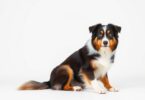Over 60% of new pet owners underestimate their dog’s adult size, leading to challenges in housing, exercise, and care. This statistic highlights why understanding a breed’s growth potential matters—especially for hybrids like the Mini Aussiedoodle. Combining the intelligence of Miniature Australian Shepherds with the hypoallergenic traits of Poodles, these dogs offer a unique blend of charm and practicality.
Breeders like Premier Pups and Lone Star Pups note that their compact build makes them ideal for apartments or active families. Their coats vary from wavy to curly, often requiring less shedding maintenance than larger breeds. While their stature stays manageable, their energy levels reflect their herding ancestry, demanding regular playtime.
Prospective owners should consider how weight ranges (typically 15–30 pounds) align with lifestyle needs. Smaller frames mean lower food costs but also necessitate careful portion control. This article explores growth patterns, diet adjustments, and grooming strategies tailored to their proportions.
As demand rises for adaptable companions, the Mini Aussiedoodle’s popularity grows nationwide. Whether you’re a first-time adopter or expanding your furry family, knowing what to expect ensures a thriving relationship. Let’s dive into the details that shape this breed’s journey from puppyhood to adulthood.
Understanding the Fundamentals of Mini Aussiedoodle Size
Choosing the right companion involves more than just falling for a fluffy face—understanding genetic factors ensures a perfect match. Breeders categorize these hybrids into generations like F1, F1b, and F2, each influencing traits differently. Premier Pups notes F1 pups have equal Australian Shepherd and Poodle lineage, while F1b crosses an F1 with a Poodle for curlier coats.
Decoding Generation Labels
F1b puppies often stay smaller due to increased Poodle genetics, making them ideal for allergy-prone homes. F2 litters result from pairing two F1 parents, creating more variability in energy levels and build. This genetic diversity affects adult dimensions, so discussing lineage with breeders is crucial.
From Toy to Micro Mini
Terms like “Toy” or “Teacup” describe weight ranges rather than official breed standards. A Toy typically weighs 10–15 pounds, while Teacups may stay under 10 pounds. Micro Mini varieties push boundaries further but require extra health monitoring. Hybrid vigor from mixed parent breeds can enhance resilience, though consistent exercise remains vital for all sizes.
These adaptable hybrids thrive in urban and suburban settings, explaining their surge as designer pets. Knowing generational traits and size labels helps owners prepare adequately, whether selecting active playmates or compact cuddle partners.
Factors Affecting mini aussiedoodle size and Growth
Predicting a dog’s adult dimensions starts with understanding inherited traits and biological advantages. Breeders like Premier Pups emphasize that genetic diversity from crossbreeding shapes everything from height to energy needs. This blend creates pets tailored for diverse lifestyles while maintaining robust health.
Influence of Parent Breeds on Growth
The Miniature Australian Shepherd contributes agility and athleticism, while the Poodle’s genes promote a compact, sturdy frame. Physical traits like wavy coats often come from the Poodle side, whereas herding instincts stem from the Australian lineage. Mental sharpness reflects this mix, with problem-solving skills seen in both breeds.
Hybrid Vigor and Its Impact on Health
Crossing two distinct breeds reduces risks linked to purebred hereditary issues. Studies by Lone Star Pups show these hybrids often live 12–15 years due to stronger immune systems. Their intelligence also benefits from hybrid vigor, making them quick learners during training.
Owners can maximize these advantages through balanced nutrition and regular vet visits. While genetics set the foundation, attentive care ensures your pet thrives physically and mentally. This combination creates companions that are both resilient and adaptable to various living environments.
Nutrition and Feeding Guidelines for Growing Puppies
Proper nutrition shapes a puppy’s future, and for energetic hybrids, every meal matters. The right diet fuels their playful nature while supporting bone development and immune health. According to Lone Star Pups, puppies with smaller parent breeds often reach 15–25 pounds by adulthood, making portion control essential from day one.
Diet Recommendations for Each Growth Stage
Newborns (8–12 weeks) thrive on high-protein kibble softened with warm water. Transition to dry food by 12 weeks to strengthen jaw muscles. For 3–6-month-olds, meals rich in omega-3 fatty acids promote brain development and coat health. Adult formulas can start at 6–12 months, adjusted based on activity levels.
Establishing a Balanced Feeding Schedule
Feed puppies three times daily until six months old, then reduce to two meals. Measure portions using a kitchen scale—overfeeding risks joint strain. Pair meals with 30–60 minutes of playtime to balance energy intake. Owners should track weight monthly and consult vets for adjustments.
Consistency prevents digestive issues and supports lifelong vitality. Combine structured mealtimes with interactive toys to engage their sharp minds. Remember: a well-fed puppy grows into a resilient, joyful companion.
Grooming and Maintenance Tips for a Healthy Coat
A well-maintained coat reflects your pet’s health and vitality. Regular grooming prevents matting, reduces allergens, and strengthens your bond. Breeders like Premier Pups recommend weekly brushing sessions using a slicker brush for wavy textures or a stainless-steel comb for tighter curls.
Brushing and Bathing Essentials
Focus on areas prone to tangles, like behind the ears and under the legs. Use hypoallergenic shampoo every 4–6 weeks to preserve natural oils—Lone Star Pups suggests oatmeal-based formulas for sensitive skin. For unique colors like blue merle, avoid sun exposure after baths to prevent fading.
Nail, Ear, and Dental Care Best Practices
Trim nails monthly to avoid overgrowth that affects posture. Clean ears weekly with vet-approved solution to prevent infections. Brush teeth 3–4 times weekly using enzymatic toothpaste. These routines prevent common issues while highlighting your companion’s vibrant characteristics.
Invest in quality tools: curved shears for precise trimming and rubber-tipped brushes for delicate skin. Patterns like parti-color may require color-enhancing conditioners. Consistent care ensures your pet stays comfortable, confident, and ready for adventure.
Exercise, Training, and Socialization for a Happy Pet
Balanced routines keep these hybrids mentally sharp and physically thriving. Their herding ancestry means they crave purposeful activity, not just casual walks. Lone Star Pups recommends combining structured exercise with interactive challenges to match their lively temperament.
Daily Exercise Needs and Playtime Activities
Plan 45–60 minutes of daily activity split into two sessions. Morning walks build endurance, while afternoon games like fetch or agility courses stimulate problem-solving skills. Puzzle toys filled with treats engage their intelligence during downtime.
Rotate activities weekly to prevent boredom—hide-and-seek sessions or scent-tracking games work well. Swimming sessions offer low-impact workouts for growing joints. Pair physical exertion with quiet bonding time to balance their energy levels.
Effective Training Techniques Using Positive Reinforcement
Short 10-minute sessions yield better results than marathon drills. Reward desired behaviors immediately with praise or small treats. Teach commands like “leave it” early to manage their curiosity around new environments.
Socialization starts at 8–12 weeks with controlled introductions to people, pets, and sounds. Enroll in puppy classes to reinforce manners around other companions. Consistent routines build trust, transforming spirited pups into confident family members.
For those juggling busy schedules, comprehensive care strategies offer adaptable solutions. Remember: patience and playfulness strengthen your bond while shaping a well-adjusted pet.
Health and Lifespan Considerations
Regular care and early detection are key to helping your furry friend thrive for 12–15 years. These energetic companions often enjoy robust health, but proactive measures ensure they remain vibrant family members. Let’s explore how to safeguard their well-being through every life stage.
Common Health Issues and Preventative Measures
Hip dysplasia and eye conditions like progressive retinal atrophy occasionally affect smaller hybrids. Annual vet screenings catch these issues early, especially in families with active children. Allergies or skin sensitivities may arise—switching to hypoallergenic diets often resolves itching or redness.
Monitor energy levels closely. Sudden lethargy could signal joint discomfort or thyroid imbalances. Brush their coat weekly to check for lumps, and measure their height in inches during growth phases to spot irregularities.
Regular Vet Check-Ups and Maintaining Vitality
Schedule wellness exams every six months for puppies under two years old. Bloodwork and dental cleanings prevent long-term complications. For adult pets, track weight fluctuations and adjust exercise routines to match their stamina.
Engage families in daily play to strengthen bonds and maintain muscle tone. Simple routines like evening walks or puzzle games keep minds sharp. By pairing preventative care with joyful activities, you’ll nurture a resilient companion ready to grow alongside children for years to come.
Exploring the History and Legacy of the Mini Aussiedoodle
Behind every beloved designer dog lies a story of purposeful innovation. The Mini Aussiedoodle’s journey began when breeders sought to combine the best qualities of two iconic parent breeds. Their legacy reflects America’s shifting preferences for adaptable companions that thrive in modern lifestyles.
Origins of the Miniature Australian Shepherd and Mini Poodle
The Miniature Australian Shepherd emerged in the 1960s as ranchers needed smaller herding dogs. Bred from standard Australian Shepherds, these compact workers retained their ancestors’ intelligence and agility. Meanwhile, Mini Poodles descended from European water retrievers, prized for their hypoallergenic coats and trainable nature.
The Evolution of a Designer Breed in the United States
By the 1990s, U.S. breeders intentionally crossed these breeds to create pets suited for urban living. Premier Pups notes this fusion addressed growing demand for low-shedding dogs with lively personalities. The result? A versatile hybrid that excels in apartments and active households alike.
Today’s Aussiedoodles inherit their parents’ resilience and charm, making them ideal for diverse families. Their rise mirrors America’s love for pets that balance work ethic with affectionate companionship. Understanding this heritage helps owners appreciate the traits that make these dogs enduring favorites nationwide.
Embracing Your Pet’s Journey with Confidence
Raising a pet is like nurturing a lifelong friendship—one built on trust, adaptability, and shared growth. These hybrids blend the best traits of their parent breeds, offering loyalty, intelligence, and hypoallergenic coats. Their reputation as premier designer companions stems from this balanced mix of practicality and charm.
Every stage of their development brings opportunities to strengthen your bond. Whether teaching new commands or exploring outdoor adventures, their enthusiasm mirrors your commitment. For those considering similar breeds, exploring top Poodle crossbreeds can reveal other adaptable options.
Owners thrive by staying proactive. Schedule regular vet check-ups, prioritize mental stimulation, and celebrate small milestones. These steps ensure your companion remains healthy and engaged throughout their 12–15-year lifespan.
Ultimately, the joy of pet ownership lies in embracing both challenges and triumphs. With their spirited personalities and resilient nature, these dogs exemplify the rewards of thoughtful care. By understanding their unique traits, you’ll craft a fulfilling journey for you and your devoted companion.
FAQ
What role does hybrid vigor play in this breed’s health?
Crossbreeding Australian Shepherds with Poodles often reduces inherited conditions like hip dysplasia. However, responsible breeders should still screen parent dogs for eye issues and cardiac concerns to maximize hybrid vigor benefits.
How much exercise do these dogs need daily?
They thrive with 45–60 minutes of activity split between walks, fetch, and puzzle toys. Their herding heritage means mental stimulation is as crucial as physical exercise to prevent boredom-related behaviors.
How do different generations (F1, F1b) affect a Mini Aussiedoodle’s traits?
F1 pups (50% Australian Shepherd, 50% Poodle) often show varied coat textures and energy levels. F1b mixes (75% Poodle) typically have curlier, low-shedding coats, making them better for allergy-prone families. Traits like intelligence and size can vary based on lineage.Z










Leave a Comment